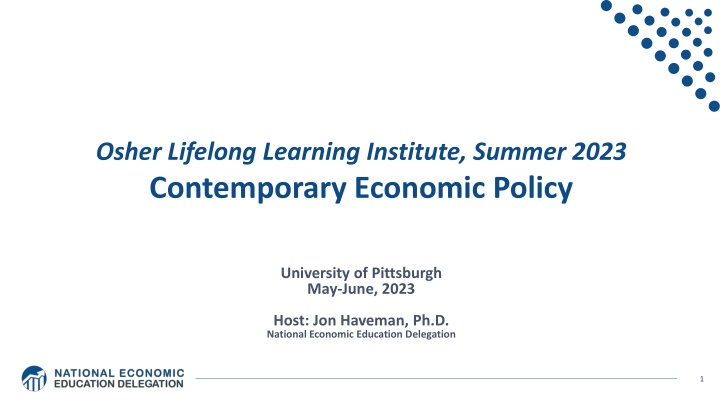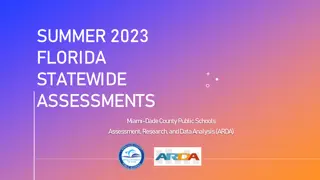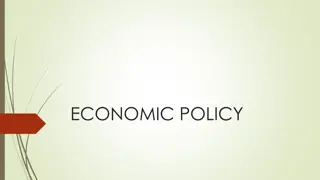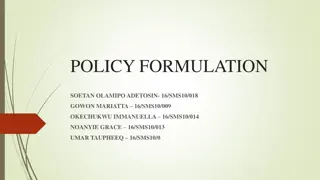Summer 2023 Economic Policy Overview
Dive into the Summer 2023 program by Osher Lifelong Learning Institute at the University of Pittsburgh. Explore contemporary economic policies, including topics on US economy, immigration economics, healthcare policies, and more. Engage with experts like Jon Haveman, Ph.D., and discover insights on Federal budgets, economic inequality, and global trade dynamics. Uncover the nuances of the Economics of Immigration and why people migrate, along with historical perspectives. Submit questions for a verbal Q&A session and access course materials for an enriching learning experience.
Download Presentation

Please find below an Image/Link to download the presentation.
The content on the website is provided AS IS for your information and personal use only. It may not be sold, licensed, or shared on other websites without obtaining consent from the author.If you encounter any issues during the download, it is possible that the publisher has removed the file from their server.
You are allowed to download the files provided on this website for personal or commercial use, subject to the condition that they are used lawfully. All files are the property of their respective owners.
The content on the website is provided AS IS for your information and personal use only. It may not be sold, licensed, or shared on other websites without obtaining consent from the author.
E N D
Presentation Transcript
Osher Lifelong Learning Institute, Summer 2023 Contemporary Economic Policy University of Pittsburgh May-June, 2023 Host: Jon Haveman, Ph.D. National Economic Education Delegation 1
Available NEED Topics Include: US Economy Immigration Economics Healthcare Economics Housing Policy Climate Change Federal Budgets Economic Inequality Federal Debt Economic Mobility Black-White Wealth Gap Trade and Globalization Autonomous Vehicles Minimum Wages Healthcare Economics 2
Course Outline Contemporary Economic Policy - Week 1 (5/17): US Economic Update (Jon Haveman, NEED) - Week 1 (5/24): US Economic Update (Geoffrey Woglom, Amherst College) - Week 2 (5/31): Federal Debt (Brian Peterson, Lagrange College) - Week 3 (6/7): Economics of Immigration (Jon Haveman, NEED) - Week 4 (6/14): Economic Mobility (Jon Haveman) - Week 5 (6/21): The Gender Wage Gap (Jon Haveman) 3
Submitting Questions Please submit questions of clarification in the chat. - I will try to handle them as they come up. We will do a verbal Q&A once the material has been presented. Slides will be available from the NEED website tomorrow (https://needecon.org/delivered_presentations.php) 4
The Economics of Immigration Jon Haveman, Ph.D. NEED 5
Outline What is immigration? Why do people migrate? History of immigration to the US Economics of immigration
What Is Immigration? Immigration - The action of coming to live in another country. Emigration - The act of leaving one s own country and going to live in another country. 7
Why Do People Migrate? Push factors: - Disparities in income/standards of living, and the availability of jobs, violence, climate change, population pressures, economic dislocation, religious persecution, or denial of political rights. Pull factors: - Potential for prosperity (higher wages, job opportunities), physical security, and political or religious liberty. 8 Source: Gilder Lehrman Institute of American History.
Recent Push Factors from Central America Hurricane Mitch in Honduras and Nicaragua in 1998. Two massive earthquakes in El Salvador in 2001. Prolonged droughts in El Salvador and Guatemala in 2013-14. Very high level of violence and crime and continued political instability especially in El Salvador, Guatemala and Honduras. All have contributed to large emigration from the region. 9
Why Do People Migrate? Levels of Decision-Making Individual level: - Economic opportunity, escape social turmoil. Family level: - Desire of the family to improve its security or level of economic well-being. - Remittances Structural or Institutional: - War, better information about opportunities, easier transportation, income differentials between countries. - Changes in immigration policies. 10 Source: Gilder Lehrman Institute of American History.
History of US Immigration Source Regions African countries* Pre-1790 Source Regions African countries* 1790-1820 300,000 85,000 England 300,000 Scotland-Ireland 50,000 Scotland-Ireland 100,000 England 45,000 Germany 100,000 France 40,000 Scotland 75,000 Germany 25,000 * Slave trade and clearly not voluntary or reflective of standard motivations for immigration. 11 Source: https://www.libertyellisfoundation.org/immigration-timeline/.
History of US Immigration Source Countries 1820-1880 Germany 3,000,000 Ireland 2,800,000 Britain 2,000,000 Austro-Hungarian empire 1,000,000 Canada 750,000 China 230,000 African countries 50,000 12 https://www.libertyellisfoundation.org/immigration-timeline
History of US Immigration Source Countries 1880-1930 Italy 4,600,000 Austro-Hungarian empire 4,000,000 Russian empire 3,300,000 German empire 2,800,000 Britain 2,300,000 Canada 2,300,000 Ireland 1,700,000 13 https://www.libertyellisfoundation.org/immigration-timeline
History of US Immigration Source Countries 1930-1965 Germany 940,000 Canada 900,000 Mexico 610,000 Britain 480,000 Italy 390,000 Caribbean/ West Indies 310,000 14 Source: https://www.libertyellisfoundation.org/immigration-timeline/.
History of US Immigration: 1965-2021 Source Country 1965-2017 Mexico 4,300,000 Immigration Reform and Control Act, 1986 - Amnesty program, 3 million Philippines 1,400,000 South Korea 760,000 Dominican Republic 750,000 India 740,000 Cuba 700,000 Vietnam 700,000 Canada 650,000 15 Source: https://www.libertyellisfoundation.org/immigration-timeline/.
Immigration policy had a big impact on: - Volumes of immigrants - Source countries 16 Source: Cato Institute, A Brief History of U.S. Immigration Policy from the Colonial Period to the Present Day, August 3, 2021.
History of US Immigration: 2011-2020 Sources (top 9) 2011-2020 Total immigrant inflow, 2011-2020 = 10,125,000 Mexico 1,491,000 China 721,000 US population growth, 2011-2020 = 22,700,000 India 637,000 Philippines 505,000 Typical year during decade Dominican Rep. 487,000 US population increased by 2.27 million (0.74%) Cuba 473,000 Native births contributed approx. 1.35 million (0.44%) Vietnam 334,000 El Salvador 215,000 Immigration contributed approx. 920,000 (0.30%) South Korea 199,000 Jamaica 198,000 17 Sources: UN Population Division (2010 and 2020 immigrant stocks), US DHS (2010-2020 immigrant inflows), US Census (population values).
Immigrant Population in 2017 Categories of the total number of immigrants in the United States. 20 https://www.pewresearch.org/fact-tank/2019/07/12/how-pew-research-center-counts-unauthorized-immigrants-in-us/
U.S. Unauthorized Immigration Totals 21 Source: Pew Research Center, 5 facts about illegal immigration in the U.S., June 12, 2019
Recent Declines in the Unauthorized Population 22 Source: Pew Research Center, 5 facts about illegal immigration in the U.S., APRIL 13, 2021
U.S. Unauthorized Immigration: Labor Force 23 Pew Research Center, 5 facts about illegal immigration in the U.S., June 12, 2019
US Unauthorized Immigration: Duration 24 Pew Research Center, 5 facts about illegal immigration in the U.S., June 12, 2019
Unauthorized Immigration: Education 25 Pew Research Center, U.S. unauthorized immigrants are more proficient in English, more educated than a decade ago, May 23, 2019
Unauthorized Immigration: 2012-2016 27 https://www.migrationpolicy.org/programs/data-hub/charts/unauthorized-immigrant-populations-country-and-region-top-state-and-county
Unauthorized Immigration: Mode of Entry Entry w/o Inspection 28
Most Are Single Adults Evidence suggests: - Most unaccompanied minors are coming to join family members who are already here. - U.S. without a parent has not increased. The population of minors in the 30 Source: Pew Research Center, US Customs and Border Protection
Mexico: No Longer the Primary Source Northern Triangle: - El Salvador - Guatemala - Honduras 31 Source: Pew Research Center, US Customs and Border Protection
14% 32 https://www.migrationpolicy.org/programs/data-hub/us-immigration-trends#history
Why Do We Care? Economic Implications Gross Domestic Product (GDP) Labor markets: Wages and Jobs Innovation, Entrepreneurship, and Inequality Government Revenue and Spending Exports, Imports, and Foreign Direct Investment (FDI) Crime 33
GDP, Labor Markets, and Innovation, Entrepreneurship, and Inequality 34
Two Sets of Implications Aggregate effects: The size of the pie Income distribution: The size of slices of the pie 35
GDP: How Does This Work? What determines the size of an economy? - Technology/productivity - Physical capital - The number of workers o Immigration adds to the number of workers. Number of immigrants in the labor force is high - 28.2 million foreign-born persons ages 16+ in the labor force in 2018. - 17.4% of the total US workforce. Evidence - Immigrants added 11% to GDP ($2 trillion) in 2016. 36
Immigration Is Similar to Trade Trade - Allows production to be brought to where the low-wage workers are. Immigration - Allows workers to move to where high-wage jobs are. Both: - Equalize wages geographically - Lower prices - Increase overall economic activity 37
Labor Market Implications: Complicated Depends on the type of immigrant: Skills/education - Similar to native-born population? - Low-skilled? - Highly skilled? Brings capital market implications - Low-skilled immigrants capital supplementing - Highly skilled immigrants capital complementing 38 Source: Hong & McLaren (2015).
Pattern of Immigration Educational Attainment of Recent Immigrants Last 5 Decades 39 Source: Blau & Mackie (2017), p. 88.
Labor Market Implications Provides net benefits to the receiving economy - Larger labor supply. - Changes in labor prices increase production of goods and services that use the type of labor offered by immigrants. Short run: there are winners and losers - Changes in wage structure and returns to capital affect native-born workers differently. Long run: could be no winners, but also no losers - The economy might adjust to pre-immigration wage structure and returns to capital. No change for native-born individuals. 41
Potential Benefits for Low-Skilled Native Workers Immigration can increase native-born worker wages: - More demand for jobs where English is necessary. - Increased demand for goods and services o Increases wages in those industries. - Each immigrant creates 1.2 local jobs mostly for native-born workers. 42 Source: Hong & McLaren (2015).
Pathway of Wage and Employment Effects Inflows of Low-Skilled Immigrants Order of Impact Previous Immigrants Impact is negative, but smaller at each step. Disadvantaged Minorities Native-born HS Dropouts Positive influence on wages and employment of other workers. 43
Skilled Immigrants and Innovation 1% increase in the share of the immigrant college graduate population. - 9-18% increase in patenting per capita. - Increased immigration increases patenting by native-born population. - Nonetheless, the effect is positive. In the 1990s: - Increased skilled immigration can account for one-third of increased patenting in that decade. - This translates into a 1.4-2.5% increase in GDP per capita by the end of the decade. 44
Immigrants and Entrepreneurship Self-Employment Rates by Nativity 45 Source: Magnus Lofstrom from Current Population Survey Data.
Fortune 500: First- and Second-Generation Founders 47
Immigration and Inequality Beginning in about 1970, the immigrant share of the US population increased dramatically. - 5% in 1970 and 14% in 2016 Compared to the native born, immigrants: - Comprise a larger share of less-educated workers (less than HS diploma) - Comprise a larger share of highly educated workers (advanced degree) Immigration has likely increased income inequality. Its effect has likely been small. - ~5% between 1980 and 2000 - No reason to think it has been bigger since then 48
Immigration and Inequality 49 Source: Ping Xu, James C. Garand, and Ling Zhu, How immigration makes income inequality worse in the U.S. (October 2015), Figure 1.
Immigration and Prices How do immigrants lower prices? - Demand side o A higher proportion of immigrants tends to make markets more price sensitive. o Accordingly, stores are reluctant to raise prices. - Supply side o By providing labor services at lower cost. o Input prices are lowered, so final goods prices are also likely to be lower. o Primarily in nontraded sectors Household services, construction, hospitality, agriculture. 50























